The following list covers radioisotopes created in nuclear reactors by neutron flux for nuclear medicine.
Bismuth-213 has a half life of 46 minutes. It is used for Targeted Alpha Therapy.
Chromium-51 has a half life of 28 days. It is used to label red blood cells and quantify gastro-intestinal protein loss.
Cobalt-60 has a half life of 10.5 months. It is used for external beam radiotherapy.
Copper-64 has a half life of 13 hours. It is used to study genetic diseases affecting copper metabolism.
Dysprosium-165 has a half life of 2 hours. It is used as an aggregated hydroxide for synovectomy treatment of arthritis.
Erbium-169 has a half life of 9.4 days. It is used for relieving arthritis pain in synovial joints.
Holmium-166 has a half life of 26 hours. It is used for diagnosis and treatment of liver tumors.
Iodine-125 has a half life of 60 days. It is used in cancer therapy where a radioactive pellet is implanted in the prostate gland or the brain. It is also used diagnostically to evaluate the filtration rate of kidneys and to diagnose deep vein thrombosis in the leg. It is can also be used to detect tiny amounts of hormones.
Iodine-131 has a half life of 8 days. It is used in treating thyroid cancer and in imaging the thyroid. It is also used in diagnosis of abnormal liver function, kidney blood flow and urinary tract obstruction.
Iridium-192 has a half life of 74 days. It is used in the form of a wire for internal implantation for cancer treatment.
Iron-59 has a half life of 46 days. It is used in studies of iron metabolism in the spleen.
Lutetium-177 has a half life of 6.7 days. It is used in therapy on small tumors found in endocrine glands.
Molybdenum-99 has a half life of 66 hours. It is used to produce technetium-99m.
Palladium-103 has a half life of 17 days. It is used to make permanent implant seeds for early stage prostate cancer treatment.
Phosphorus-32 has a half life of 14 days. It is used in the treatment of a condition involving excess red blood cells.
Potassium-42 has a half life of 12 hours. It is used for the evaluation of exchangeable potassium in coronary blood flow.
Rhenium-186 has a half life of 3.8 days. It is used for pain relief in bone cancer.
Rhenium-188 has a half life of 17 hours. It is used to irradiate coronary arteries from an angioplasty balloon.
Samarium-153 has a half life of 47 hours. It is used to relieve the pain of secondary cancers in the bones. It is also effective for pain caused by prostate and breast cancer.
Selenium-75 has a half life of 120 days. It is used to study the production of digestive enzymes.
Sodium-24 has a half life of 15 hour. It is used for studies of electrolytes in the body.
Strontium-89 has a half life of 50 days. It is used to reduce the pain of prostate and bone cancer.
Technetium-99m has a half life of 6 hours. It is used in to image the skeleton, heart muscles, brain, thyroid, lungs, liver, spleen, kidneys gall bladder, bone marrow, salivary and tear glands.
Xenon-133 has a half life of 5 days. It is used for lung ventilation studies.
Ytterbium-169 has a half life of 32 days. It is used for cerebrospinal fluid studies in the brain.
Yttrium-90 has a half life of 64 hours. It is used for cancer therapy by implantation in large joints for the relief of the pain of arthritis.
The image below shows a catheter inserting a radioactive wire into a tumor.
